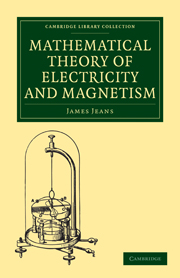Book contents
- Frontmatter
- Preface
- Contents
- Introduction
- ELECTROSTATICS AND CURRENT ELECTRICITY
- CHAP. I Physical Principles
- CHAP. II The Electrostatic Field of Force
- CHAP. III Conductors and Condensers
- CHAP. IV Systems of Conductors
- CHAP. V Dielectrics and Inductive Capacity
- CHAP. VI The State of the Medium in the Electrostatic Field
- CHAP. VII General Analytical Theorems
- CHAP. VIII Methods for the Solution of Special Problems
- CHAP. IX Steady Currents in Linear Conductors
- CHAP. X Steady Currents in Continuous Media
- MAGNETISM
- ELECTROMAGNETISM
- INDEX
CHAP. IV - Systems of Conductors
from ELECTROSTATICS AND CURRENT ELECTRICITY
Published online by Cambridge University Press: 05 August 2011
- Frontmatter
- Preface
- Contents
- Introduction
- ELECTROSTATICS AND CURRENT ELECTRICITY
- CHAP. I Physical Principles
- CHAP. II The Electrostatic Field of Force
- CHAP. III Conductors and Condensers
- CHAP. IV Systems of Conductors
- CHAP. V Dielectrics and Inductive Capacity
- CHAP. VI The State of the Medium in the Electrostatic Field
- CHAP. VII General Analytical Theorems
- CHAP. VIII Methods for the Solution of Special Problems
- CHAP. IX Steady Currents in Linear Conductors
- CHAP. X Steady Currents in Continuous Media
- MAGNETISM
- ELECTROMAGNETISM
- INDEX
Summary
In the present Chapter we discuss the general theory of an electrostatic field in which there are any number of conductors. The charge on each conductor will of course influence the distribution of charges on the other conductors by induction, and the problem is to investigate the distributions of electricity which are to be expected after allowing for this mutual induction.
We have seen that in an electrostatic field the potential cannot be a maximum or a minimum except at points where electric charges occur. It follows that the highest potential in the field must occur on a conductor, or else at infinity, the latter case occurring only when the potential of every conductor is negative. Excluding this case for the moment, there must be one conductor of which the potential is higher than that anywhere else in the field. Since lines of force run only from higher to lower potential (§ 36), it follows that no lines of force can enter this conductor, there being no higher potential from which they can come, so that lines of force must leave it at every point of its surface. In other words, its electrification must be positive at every point.
So also, except when the potential of every conductor is positive, there must be one conductor of which the potential is lower than that anywhere else in the field, and the electrification at every point of this conductor must be negative.
- Type
- Chapter
- Information
- Mathematical Theory of Electricity and Magnetism , pp. 88 - 114Publisher: Cambridge University PressPrint publication year: 2009First published in: 1908

